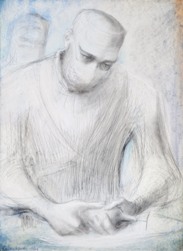When I re-read a lecture that British sculptor, Dame Barbara Hepworth gave about 1953 to a group of surgeons, it seemed well worth repeating (courtesy of the Bowness, Hepworth Estate). Barbara Hepworth was a very good draughtswoman, and as a result of her daughter, Sarah, spending time in hospital in 1944, she became close friends with Norman Capener, a surgeon who treated Sarah at the Princess Elizabeth Orthopaedic Hospital in Exeter. He invited her to be present in operating theatres in Exeter and at the London Clinic, during surgical procedures, so that she could draw different scenes of the operations. As a result, she produced, between 1947-49, nearly 80 drawings of operating rooms in pencil, chalk, ink and oil paint on board. She became fascinated by the similarities between surgeons and artists, particularly with the rhythmic motions of hands.
She wrote, after being in the operating theatre in Exeter, "I expected that I should dislike it; but from the moment when I entered the operating theatre I became completely absorbed by two things: first, the co-ordination between human beings all dedicated to the saving of a life, and the way that unity of idea and purpose dictated a perfection of concentration, movement, and gesture, and secondly by the way this special grace (grace of mind and body), induces a spontaneous space composition, an articulated and animated kind of abstract sculpture very close to what I had been seeking in my own work."
In her c. 1953 lecture, she reiterated this unity of idea and purpose.
"There is, it seems to me, a very close affinity between the work and approach both of physicians and surgeons, and painters and sculptors. In both professions, we have a vocation and we cannot escape the consequences of it.
The medical profession, as a whole, seeks to restore and to maintain the beauty and grace of the human mind and body; and, it seems to me, whatever illness a doctor sees before him, he never loses sight of the ideal, or state of perfection, of the human mind and body and spirit towards which he is working."
"The artist, in his sphere, seeks to make concrete ideas of beauty which are spiritually affirmative, and which, if he succeeds, become a link in the long chain of human endeavor which enriches man's vitality and understanding, helping him to surmount his difficulties and gain a deeper respect for life."
"The abstract artist is one who is predominantly interested in the basic principles and unifying structures of things, rather than in the particular scene or figure before him."









